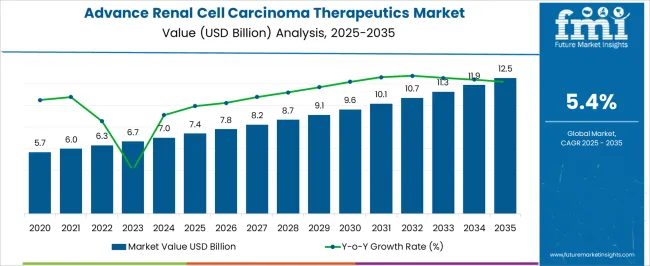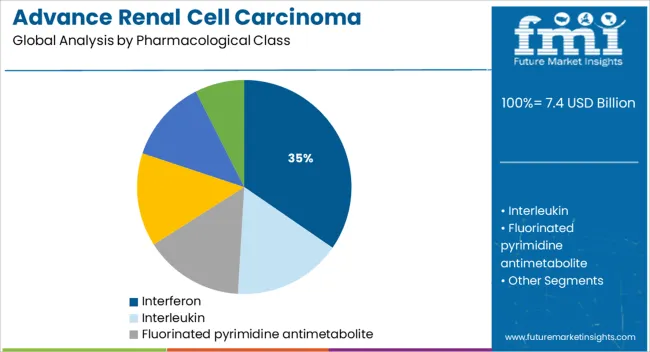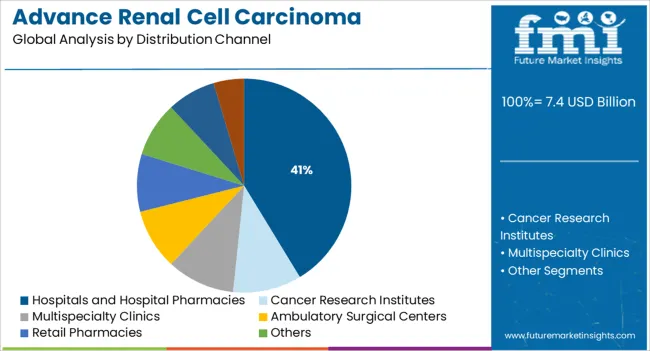The Advance Renal Cell Carcinoma Therapeutics Market is estimated to be valued at USD 7.4 billion in 2025 and is projected to reach USD 12.5 billion by 2035, registering a compound annual growth rate (CAGR) of 5.4% over the forecast period.

| Metric | Value |
|---|---|
| Advance Renal Cell Carcinoma Therapeutics Market Estimated Value in (2025 E) | USD 7.4 billion |
| Advance Renal Cell Carcinoma Therapeutics Market Forecast Value in (2035 F) | USD 12.5 billion |
| Forecast CAGR (2025 to 2035) | 5.4% |
The advance renal cell carcinoma therapeutics market is witnessing notable progress driven by increased incidence of renal malignancies, enhanced diagnostic capabilities, and growing demand for targeted treatment modalities. As survival rates improve through early detection and personalized medicine, the therapeutic landscape has evolved with innovative pharmacological classes and biologics gaining regulatory traction.
Clinical research has accelerated, focusing on immune modulation and angiogenesis inhibition to deliver superior efficacy and fewer adverse effects. The rising burden of advanced stage diagnoses and an aging global population have further contributed to therapeutic uptake.
Health systems are prioritizing timely treatment access and improving oncology care pathways, particularly in hospital based settings. With continued investment in drug development, pipeline expansion, and treatment accessibility, the market is expected to experience sustained momentum in both high income and developing healthcare systems.
The market is segmented by Pharmacological Class and Distribution Channel and region. By Pharmacological Class, the market is divided into Interferon, Interleukin, Fluorinated pyrimidine antimetabolite, Tyrosine kinase inhibitors, Rapamycin-derivative kinase inhibitor, and Multityrosine kinase inhibitor. In terms of Distribution Channel, the market is classified into Hospitals and Hospital Pharmacies, Cancer Research Institutes, Multispecialty Clinics, Ambulatory Surgical Centers, Retail Pharmacies, Others, Palliative Care Centers, and Long Term Care Centers. Regionally, the market is classified into North America, Latin America, Western Europe, Eastern Europe, Balkan & Baltic Countries, Russia & Belarus, Central Asia, East Asia, South Asia & Pacific, and the Middle East & Africa.

The interferon segment is anticipated to account for 34.60% of total market revenue by 2025 under the pharmacological class category, making it a major component of therapeutic regimens. Its continued relevance is supported by its immunomodulatory effects and historical usage as one of the earliest biological therapies for advanced renal cell carcinoma.
Despite the rise of newer agents, interferon maintains clinical significance in specific patient cohorts where immune-based response remains a viable option. Cost effectiveness and established safety profiles also contribute to its sustained adoption, especially in markets where access to next generation therapies is limited.
Its compatibility with combination protocols and ability to induce durable responses in select patients further bolster its presence in the treatment landscape.

The hospitals and hospital pharmacies segment is projected to represent 41.30% of overall market revenue by 2025, solidifying its role as the dominant distribution channel. This prominence is driven by the centralized nature of oncology care delivery, where advanced therapies are administered under close clinical supervision.
Hospitals serve as primary points for diagnosis, treatment planning, and therapeutic intervention, particularly for complex and late stage cancers such as advanced renal cell carcinoma. Hospital pharmacies facilitate controlled distribution of high cost and high risk therapeutics while ensuring proper handling and adherence to oncology protocols.
Additionally, insurance reimbursements and structured care pathways within institutional settings support higher patient throughput, positioning this channel as the cornerstone of therapeutic delivery in the renal oncology domain.
The advance renal cell carcinoma therapeutics market has witnessed an unprecedented surge in the past few years. There has been an approximate surge of USD 0.32 Billion from the base year to the current. This market growth can be attributed to the availability of novel drugs, a robust increase in the prevalence of renal cancer, and the presence of a robust pipeline.
FMI has analyzed that there is a rise in the geriatric population across the globe, and the urban populace is very inclined toward endorsing a prominent smoking habit. These incidences are the key causes behind the rapid propulsion of the advanced renal cell carcinoma therapeutics market. The industry is witnessing a dramatic change in the therapeutics paradigm. The manufacturers of advanced renal cell carcinoma therapeutics in the market are shifting their focus toward more targeted immunotherapies.
Owing to the reduced physical activities and rise in smoking and drinking, there is a mounting incidence of kidney cancer. Fast-emerging and strong pipeline treatments are expected to boost the expansion of the advanced renal cell carcinoma therapeutics industry through the forecast period. However, it has also been analyzed that a very high cost is associated with the therapeutics, which is likely to curb the growth of the market in the long run.
Additionally, looming-off patients and uncertain policies of reimbursement are some key restraints identified in the proliferation of the advanced renal cell carcinoma therapeutics market. FMI sheds some light on the fact that untapped geographies across the world have a large number of undiagnosed patients. This aspect is likely to offer lucrative growth opportunities for the manufacturers in the estimated study period. However, the innovators may witness some threats while competing with generic drugs.
The manufacturers in the advance renal cell carcinoma therapeutics market are leveraging advancements in technology to launch new products and gain a competitive advantage. These firms are continually investing in research and development activities to keep themselves in tandem with the changing consumer preferences and end-use industry demands. Efforts are being made to strengthen their foothold in the market and aid the further progression of the advance renal cell carcinoma therapeutics market. Thus, the market is likely to witness significant growth through 2035.
Renal cell carcinoma is one of the fastest growing disease of solid tumor oncology. From past couple of decades, there has been a dramatic alteration in the clinical framework that shapes both renal cell carcinoma understanding and treatment. Renal cell carcinoma is a malignancy that in advanced disease stages is highly resistant to systemic therapies.
Advanced surgical interventions and novel drugs, have enhanced patient survival and prolonged clinically stable-disease states. The proportion of small and incidental renal tumors has significantly increased owing to the extensive use of abdominal imaging, e.g. ultrasonography, computed tomography (CT) and magnetic resonance imaging (MRI).
Renal cell carcinoma is the eighth most common malignancy, which affects the adults, and it accounts for between 3% and 4% of new, different cancer cases globally. Statistically, it has been analyzed that renal cell carcinoma is the seventh common cancer in male and the ninth most common cancer in the female by various famed research institutes.
Renal cell carcinoma represents hereditary disorders with distinct cytogenetic and immune-histochemical properties that have contradictory prognoses, imaging characteristics, and potential morbidities.
Increase in aging population is one of the major factors driving the revenue growth of the renal cell carcinoma market. Furthermore, renal cell carcinoma is a rare disease with a small patient-base constitutingall ages from infants to older adults.However, the disease is predominantly noted in age group of ~ 60-70 years, exposing a higher probability of occurrence.
Expanding research into orphan drugs is a factor projected to create lucrative revenue potential for drug makers of renal cell carcinoma.
Restraints include lack of technological advances in genome sequencing, stagnant number of diagnosed population base and low patient awareness levels among others.The disease pattern of renal cell carcinoma disease is also affected by the genomic alteration, changes in lifestyle etc. Other inevitable restraints include lack of product availability on specific diseases target indications apart from feeble pipeline.
Advance Renal Cell Carcinoma Therapeutics Market is projected to decline during the forecast period due slow results of clinical trials with lack of safety data. Indeed, the advance renal cell carcinoma therapeutics market would show a stagnant CAGR due to increase in population in developing countries.
While innovations like change in mode of action are being adapted; technical advancements in treatment procedures are expected to make the market shift significantly. The weak drug pipeline and lack of differentiation in drug therapy may hinder the progress of the advance renal cell carcinoma therapeutics market.
Based on geographic regions, advance renal cell carcinoma therapeutics market is segmented into seven key regions: North America, Latin America, Eastern Europe, Western Europe, Japan, Asia Pacific and Middle East Africa. North America accounts for major revenue share in the global market of the disease, owing to an increasingly aging population and rising awareness towards innovative drug therapies.
The pattern is closely followed by markets in Western Eastern Europe and Asia Pacific regions. Lower acceptance of combination therapies followed by lack of facilities in disease diagnosis are factors that may have a negative impact on revenue generation from renal cell carcinoma therapeutics.
The advance renal cell carcinoma therapeutics market in Japan will have a constant growth due to the balance between acceptance of combinational therapies and rising disease incidence due to changes in lifestyle. Markets in Middle East and Africa pose lucrative revenue generation opportunities for players in the renal cell carcinoma therapeutics market. This is fuelled by increasing expenditure on healthcare from foreign countries in the region to cover a large untapped patient population base.
Key drug manufacturers targeting advance renal cell carcinoma therapeutics market include Exelixis, Bristol-Myers Squibb, Novartis, Pfizer, Eisai Co., Ltd, Genentech, GlaxoSmithKline, and Bayer among others.
The research report presents a comprehensive assessment of the market and contains thoughtful insights, facts, historical data, and statistically supported and industry-validated market data. It also contains projections using a suitable set of assumptions and methodologies. The research report provides analysis and information according to categories such as market segments, geographies, types, technology and applications.
The report is a compilation of first-hand information, qualitative and quantitative assessment by industry analysts, inputs from industry experts and industry participants across the value chain.
The report provides in-depth analysis of parent market trends, macro-economic indicators and governing factors along with market attractiveness as per segments. The report also maps the qualitative impact of various market factors on market segments and geographies.
Advance Renal Cell Carcinoma Therapeutics Market can be segmented based on drugs class and distribution channel.
The global advance renal cell carcinoma therapeutics market is estimated to be valued at USD 7.4 billion in 2025.
The market size for the advance renal cell carcinoma therapeutics market is projected to reach USD 12.5 billion by 2035.
The advance renal cell carcinoma therapeutics market is expected to grow at a 5.4% CAGR between 2025 and 2035.
The key product types in advance renal cell carcinoma therapeutics market are interferon, interleukin, fluorinated pyrimidine antimetabolite, tyrosine kinase inhibitors, rapamycin-derivative kinase inhibitor and multityrosine kinase inhibitor.
In terms of distribution channel, hospitals and hospital pharmacies segment to command 41.3% share in the advance renal cell carcinoma therapeutics market in 2025.






Our Research Products

The "Full Research Suite" delivers actionable market intel, deep dives on markets or technologies, so clients act faster, cut risk, and unlock growth.

The Leaderboard benchmarks and ranks top vendors, classifying them as Established Leaders, Leading Challengers, or Disruptors & Challengers.

Locates where complements amplify value and substitutes erode it, forecasting net impact by horizon

We deliver granular, decision-grade intel: market sizing, 5-year forecasts, pricing, adoption, usage, revenue, and operational KPIs—plus competitor tracking, regulation, and value chains—across 60 countries broadly.

Spot the shifts before they hit your P&L. We track inflection points, adoption curves, pricing moves, and ecosystem plays to show where demand is heading, why it is changing, and what to do next across high-growth markets and disruptive tech

Real-time reads of user behavior. We track shifting priorities, perceptions of today’s and next-gen services, and provider experience, then pace how fast tech moves from trial to adoption, blending buyer, consumer, and channel inputs with social signals (#WhySwitch, #UX).

Partner with our analyst team to build a custom report designed around your business priorities. From analysing market trends to assessing competitors or crafting bespoke datasets, we tailor insights to your needs.
Supplier Intelligence
Discovery & Profiling
Capacity & Footprint
Performance & Risk
Compliance & Governance
Commercial Readiness
Who Supplies Whom
Scorecards & Shortlists
Playbooks & Docs
Category Intelligence
Definition & Scope
Demand & Use Cases
Cost Drivers
Market Structure
Supply Chain Map
Trade & Policy
Operating Norms
Deliverables
Buyer Intelligence
Account Basics
Spend & Scope
Procurement Model
Vendor Requirements
Terms & Policies
Entry Strategy
Pain Points & Triggers
Outputs
Pricing Analysis
Benchmarks
Trends
Should-Cost
Indexation
Landed Cost
Commercial Terms
Deliverables
Brand Analysis
Positioning & Value Prop
Share & Presence
Customer Evidence
Go-to-Market
Digital & Reputation
Compliance & Trust
KPIs & Gaps
Outputs
Full Research Suite comprises of:
Market outlook & trends analysis
Interviews & case studies
Strategic recommendations
Vendor profiles & capabilities analysis
5-year forecasts
8 regions and 60+ country-level data splits
Market segment data splits
12 months of continuous data updates
DELIVERED AS:
PDF EXCEL ONLINE
Advanced Therapeutics Pharmaceutical Outsourcing Market Size and Share Forecast Outlook 2025 to 2035
Merkel Cell Carcinoma Treatment Market
Hepatocellular Carcinoma HCC Treatment Market Size and Share Forecast Outlook 2025 to 2035
Non-Small Cell Lung Carcinoma (NSCLC) Market Size and Share Forecast Outlook 2025 to 2035
Chloangiocarcinoma (CCA) Therapeutics Market - Growth & Drug Innovations 2025 to 2035
Unresectable Hepatocellular Carcinoma Market - Growth & Outlook 2025 to 2035
Head and Neck Squamous Cell Carcinoma Market
Anaplastic Large Cell Lymphoma (ALCL) Therapeutics Market Size and Share Forecast Outlook 2025 to 2035
Gastroesophageal Junction Adenocarcinoma Therapeutics Market by Drug, Diagnosis, Treatment, Distribution Channel, and Region through 2035
Cellulose Diacetate Film Market Size and Share Forecast Outlook 2025 to 2035
Cellulose Fiber Market Forecast and Outlook 2025 to 2035
Advanced Process Control Market Size and Share Forecast Outlook 2025 to 2035
Advanced Active Cleaning System for ADAS Market Forecast and Outlook 2025 to 2035
Cellulite Treatment Market Size and Share Forecast Outlook 2025 to 2035
Cellulose Derivative Market Size and Share Forecast Outlook 2025 to 2035
Advanced Driver Assistance System (ADAS) Testing Equipment Market Size and Share Forecast Outlook 2025 to 2035
Cellulose Film Packaging Market Size and Share Forecast Outlook 2025 to 2035
Cell Therapy Systems Market Size and Share Forecast Outlook 2025 to 2035
Cellular IoT Market Size and Share Forecast Outlook 2025 to 2035
Advanced Lead Acid Battery Market Size and Share Forecast Outlook 2025 to 2035

Thank you!
You will receive an email from our Business Development Manager. Please be sure to check your SPAM/JUNK folder too.
Chat With
MaRIA